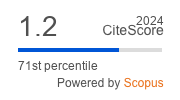Turkish, Bulgarian and German Language Mixing Among Bulgarian Muslim Roma in Germany
DOI:
https://doi.org/10.29038/eejpl.2019.6.2.kyuKeywords:
Muslim Roma, Bulgarian, code-switching, bilingualism.Abstract
The paper presents the phenomenon of language mixing with Bulgarian by Muslim Roma migrants from northeastern Bulgaria in Berlin, Germany. They identify as Turks and in their everyday communication speak mainly Bulgarian and old variety of Turkish, in the scientific literature known as Balkanized Turkish. They can speak relatively little German and have low proficiency in the language. The paper describes the language mixing as well as the forms of code-switching between Turkish, Bulgarian and German. These linguistic and social phenomena within the Muslim Roma community are analysed within the framework of several sociolinguistic theories regarding code-switching and bilingualism. The theory of J. Gumperz (1962) about communication matrix is used and patterns of Turkish- Bulgarian, Turkish-German and Turkish-Bulgarian-German are presented and analysed. The grammatical categories which are switched in the Turkish-Bulgarian-German language contacts, involve nouns, verbs, adjectives, adverbs and negations. However, code-switching is used only in communication with other Bulgarians. In communication with Turks from Turkey they switch only between Turkish and German and use another variety of Turkish.
References
- Bugarski, R. (2005). Jeziki Kultura [Language and Culture]. Beograd: Biblioteka XX vek.
- Friedman, V. (2003). Turkish in Macedonia and Beyond. Wiesbaden: Harrasowitz Verlag.
- Fishman, J. (1997). Language and ethnicity: the view from within. In F. Coulmas, (Ed.) The Handbook of Sociolinguistics. (pp. 327-343). Oxford: Blackwell Publishers.
- Giray, B. (2015). Code-switching among Bulgarian Muslim Roma in Berlin. In D. Zeyrek, C. S. Simsek, U. Atasand J. Rehbein (Eds.), Ankara papers in Turkish and Turkic linguistics. (pp. 420-430). Wiesbaden: Harassowitz.
- Gumperz, J. J. (1962). Types of linguistic communities. Anthropological Linguistics 4(1), 28-40.
- Kocheva-Lefedzhieva, A. (2004) Nemski leksikalni elementi v bulgarskite govori [German lexical elements in Bulgarian spoken discourse]. Sofia: Multprint.
- Kocheva-Lefedzhieva, A. (2017) Smeseniyat ezik na vienskite bulgari. [The mixed language of Vienna Bulgarians]. Sofia: Bukovica.
- Kyuchukov, H. 1995. The Turkish dialects of Muslim Roms (Gypsies) in Bulgaria. Journal of Turkology, 2, 305-307.
- Kyuchukov, H. (1996). Etnolingvodidaktika [Ethnolingual didactics]. Sofia: Club '90.
- Kyuchukov, H. (1997). Psicholingvistichni aspecti na rannia bilingvizam [Psycholinguistic aspects of early bilingualism]. Sofia: Yezykoznanie i Semiotika.
- Kyuchukov, H. 2007. Turkish and Roma children learning Bulgarian. Veliko Tarnovo: Faber.
- Matras, Y. (1990). On the emergence of finite subordination in Balkan Turkish. Proceedings of the Fifth International Conference on Turkish Linguistics, SOAS, (17-19 August, 1990).
- Matras, Y. (2004). Layers of convergent syntax in Macedonian Turkish. Mediterranean Language Review, 15, 63-86.
- Matras, Y. (2009). Language Contact. Cambridge: Cambridge University Press.
- Matras, Y. and Tufan, Ş. 2007. Grammatical borrowing in Macedonian Turkish. In Y. Matras and J. Sakel (Eds.), Grammatical Borrowing in Cross-linguistic Perspective. (pp. 215-227). Berlin: Mouton de Gruyter.
- Nikolskij, L.B. (1976). Sinhronnaja Lingvistika [Synchronous Linguistics]. Moskow: Nauka.
- Schiffman, H. (1997). Diglossia as a sociolinguistic situation. In F. Coulmas, (Ed.), The Handbook of Sociolinguistics. (pp. 205-216). Oxford: Blackwell Publishers.












 Creative Commons «Attribution» 4.0
Creative Commons «Attribution» 4.0